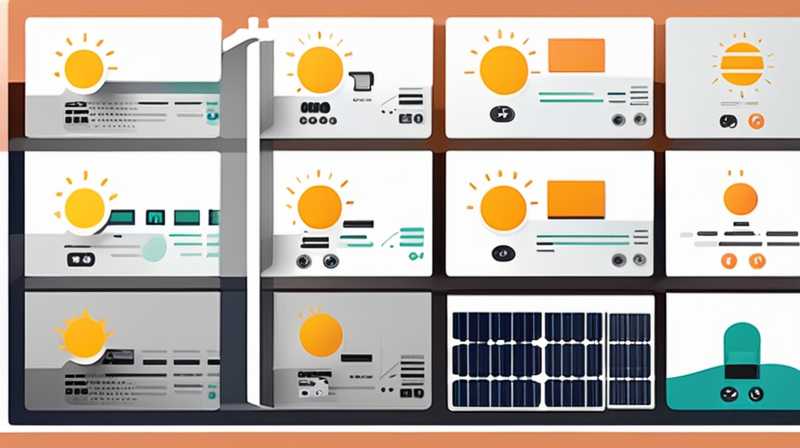
The solar components typically experiencing the briefest lifespan are 1. solar panels, 2. inverters, 3. batteries, and 4. mounting structures. Among these, inverters usually have the shortest operational life due to their electronic components that sustain wear and tear, often needing replacement every 5 to 12 years. This necessitates careful consideration for system designs to accommodate potential future inverter upgrades or changes to mitigate costs over the long haul.
1. SOLAR PANELS
Solar panels serve as the fundamental aspect of any photovoltaic system, directly converting sunlight into electricity. Their longevity is generally impressive, often boasting warranties that stretch to 25 years, yet many factors may influence the actual usage span. Environmental conditions play a pivotal role, as panels subjected to extreme heat, snow, or hail may deteriorate faster. Additionally, poor installation can cause micro-cracks in the panels, leading to reduced efficiency and shorter life expectancy.
Regular maintenance is essential for solar panels to operate optimally. Dust accumulation, bird droppings, or fallen leaves can obscure sunlight, leading to decreased energy production. Performing routine cleans and inspections can extend their lifespan, maintaining both efficiency and overall performance.
2. INVERTERS
Inverters, often termed the “heart” of solar systems, are essential for converting direct current (DC) produced by solar panels into alternating current (AC) used by the grid and home appliances. Due to their complexity and reliance on electronics, they often face the shortest lifespan of any solar component. With performance typically lasting between 5 to 12 years, inverters must be considered when calculating the total cost of ownership over a solar panel system’s life.
Temperature fluctuations can adversely affect inverter performance. They operate best within specific temperature ranges; excessive heat can lead to system failures and premature aging. Moreover, choosing high-quality inverters and ensuring their proper ventilation and installation can significantly extend their effective lifespan and performance.
3. BATTERIES
Energy storage systems, particularly batteries, are critical for maximizing solar energy utility, allowing homeowners to harness sunlight even when production is low or demand is high. However, the lifespan of batteries profoundly affects the overall efficiency and cost of solar installations. Typically, batteries last between 5 to 15 years, influenced by their type, usage patterns, and temperature exposure.
Lithium-ion batteries, while currently the most popular for residential applications, come with varied lifespans. Factors such as charge cycles, depth of discharge, and temperature can greatly impact their longevity. Battery management systems can help optimize performance by preventing overcharging and excessive discharging, thereby extending the useful life of these systems. Concerns regarding battery disposal and recycling also add another layer of complexity when evaluating overall sustainability.
4. MOUNTING STRUCTURES
Although often overlooked, mounting structures are integral components that support solar panels, affecting not only their positioning and stability but also longevity. These structures can be made from various materials, including aluminum, stainless steel, or galvanized steel. Typically, they can last between 10 and 25 years, although harsh environmental conditions can accelerate degradation, particularly for metallic components.
Corrosion can significantly diminish the lifespan of mounting brackets, especially in coastal regions where salt air is prevalent. Furthermore, installation quality greatly influences their effectiveness; misalignment or inadequate anchoring can result in structural failures or misalignment post adverse weather incidents. Thus, employing high-quality materials and skilled labor is vital in ensuring both durability and efficiency of solar systems.
FAQs
WHAT IS THE AVERAGE LIFESPAN OF SOLAR PANELS?
The general lifespan of solar panels is approximately 25 to 30 years. However, it is essential to note that while the warranty indicates the period during which performance is guaranteed, solar panels may still produce energy beyond this point, albeit at reduced efficiency. Factors such as installation quality, maintenance, and environmental conditions can also impact actual lifespans, possibly extending or reducing the years of optimal performance.
HOW DOES ENVIRONMENTAL CONDITION IMPACT SOLAR COMPONENTS?
Environmental conditions significantly affect the longevity and performance of solar components. For instance, areas with extreme temperatures, high humidity, or frequent storms may deteriorate solar panels and inverters faster than regions with moderate weather. Exposure to dust and debris can block sunlight, while moisture can lead to corrosion in electronic components. Conducting regular inspections and maintenance can help mitigate these effects and prolong the effective lifespan of solar systems.
WHAT STEPS CAN BE TAKEN TO EXTEND THE LIFESPAN OF SOLAR SYSTEMS?
To prolong the lifespan of solar systems, it is crucial to invest in regular maintenance and high-quality components. This includes cleaning solar panels to ensure optimal sunlight absorption, inspecting inverters for signs of wear, and maintaining batteries in favorable charge cycles. Moreover, choosing reputable installation services can prevent issues related to misalignment or inadequate support structures. Overall, monitoring performance through dedicated software systems can enable timely interventions to extend the overall effectiveness and longevity of solar installations.
Understanding the dual facets of efficiency and sustainability forms a crucial basis for exploring the solar industry’s future. As the move towards renewable energy intensifies, ensuring longevity and performance within solar technology cannot be underestimated. The components discussed show a range of lifespans, each impacted distinctly by both external environmental factors and internal maintenance practices.
Inverters, with their typically shorter life expectancy, demand particular attention as they play an essential role in energy conversion. While batteries are also prone to diminished lifespans due to significantly varied usage conditions, advancements in technology continue to push their effectiveness. Through diligent monitoring and strategic maintenance, it is possible to mitigate the inherent vulnerabilities associated with these essential solar components.
Prompt investment in quality installations and systems ensures that the enduring benefits of solar energy can be fully realized, enabling households and businesses to transition toward a more sustainable future. Thus, adopting optimal practices helps minimize potential replacements and maintenance costs while maximizing energy production efficiency, paving the way for a more energized tomorrow.
Original article by NenPower, If reposted, please credit the source: https://nenpower.com/blog/which-solar-components-have-the-shortest-lifespan/


